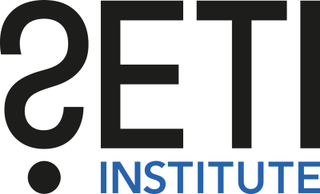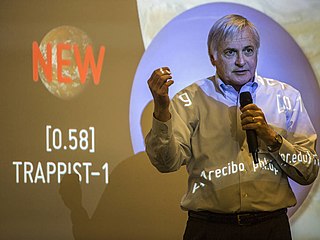Extraterrestrial life, alien life, or colloquially simply aliens is life which does not originate from Earth. No extraterrestrial life has yet been conclusively detected. Such life might range from simple forms such as prokaryotes to intelligent beings, possibly bringing forth civilizations that might be far more advanced than humanity. The Drake equation speculates about the existence of sapient life elsewhere in the universe. The science of extraterrestrial life is known as astrobiology.

The Fermi paradox is the discrepancy between the lack of conclusive evidence of advanced extraterrestrial life and the apparently high likelihood of its existence. As a 2015 article put it, "If life is so easy, someone from somewhere must have come calling by now."
The search for extraterrestrial intelligence (SETI) is a collective term for scientific searches for intelligent extraterrestrial life, for example, monitoring electromagnetic radiation for signs of transmissions from civilizations on other planets.

Frank Donald Drake was an American astrophysicist and astrobiologist.

The SETI Institute is a not-for-profit research organization incorporated in 1984 whose mission is to explore, understand, and explain the origin and nature of life in the universe, and to use this knowledge to inspire and guide present and future generations, sharing knowledge with the public, the press, and the government. SETI stands for the "search for extraterrestrial intelligence".

Seth Shostak is an American astronomer and author, and is currently the senior astronomer for the SETI Institute.
Xenoarchaeology, a branch of xenology dealing with extraterrestrial cultures, is a hypothetical form of archaeology that exists mainly in works of science fiction. The field is concerned with the study of the material remains to reconstruct and interpret past life-ways of alien civilizations. Xenoarchaeology is not currently practiced by mainstream archaeologists due to the current lack of any material for the discipline to study.

The Wow! signal was a strong narrowband radio signal detected on August 15, 1977, by Ohio State University's Big Ear radio telescope in the United States, then used to support the search for extraterrestrial intelligence. The signal appeared to come from the direction of the constellation Sagittarius and bore expected hallmarks of extraterrestrial origin.

The Allen Telescope Array (ATA), formerly known as the One Hectare Telescope (1hT), is a radio telescope array dedicated to astronomical observations and a simultaneous search for extraterrestrial intelligence (SETI). The array is situated at the Hat Creek Radio Observatory in Shasta County, 290 miles (470 km) northeast of San Francisco, California.
Active SETI is the attempt to send messages to intelligent extraterrestrial life. Active SETI messages are predominantly sent in the form of radio signals. Physical messages like that of the Pioneer plaque may also be considered an active SETI message. Active SETI is also known as METI.
A post-detection policy (PDP), also known as a post-detection protocol, is a set of structured rules, standards, guidelines, or actions that governmental or other organizational entities plan to follow for the "detection, analysis, verification, announcement, and response to" confirmed signals from extraterrestrial civilizations. Though no PDPs have been formally and openly adopted by any governmental entity, there is significant work being done by scientists and nongovernmental organizations to develop cohesive plans of action to utilize in the event of detection. The most popular and well known of these is the "Declaration of Principles Concerning Activities Following the Detection of Extraterrestrial Intelligence", which was developed by the International Academy of Astronautics (IAA), with the support of the International Institute of Space Law. The theories of PDPs constitute a distinct area of research but draw heavily from the fields of SETI, METI, and CETI.

Kepler-62f is a super-Earth exoplanet orbiting within the habitable zone of the star Kepler-62, the outermost of five such planets discovered around the star by NASA's Kepler spacecraft. It is located about 980 light-years from Earth in the constellation of Lyra.

Technosignature or technomarker is any measurable property or effect that provides scientific evidence of past or present technology. Technosignatures are analogous to biosignatures, which signal the presence of life, whether intelligent or not. Some authors prefer to exclude radio transmissions from the definition, but such restrictive usage is not widespread. Jill Tarter has proposed that the search for extraterrestrial intelligence (SETI) be renamed "the search for technosignatures". Various types of technosignatures, such as radiation leakage from megascale astroengineering installations such as Dyson spheres, the light from an extraterrestrial ecumenopolis, or Shkadov thrusters with the power to alter the orbits of stars around the Galactic Center, may be detectable with hypertelescopes. Some examples of technosignatures are described in Paul Davies's 2010 book The Eerie Silence, although the terms "technosignature" and "technomarker" do not appear in the book.

The Nexus for Exoplanet System Science (NExSS) initiative is a National Aeronautics and Space Administration (NASA) virtual institute designed to foster interdisciplinary collaboration in the search for life on exoplanets. Led by the Ames Research Center, the NASA Exoplanet Science Institute, and the Goddard Institute for Space Studies, NExSS will help organize the search for life on exoplanets from participating research teams and acquire new knowledge about exoplanets and extrasolar planetary systems.

Breakthrough Listen is a project to search for intelligent extraterrestrial communications in the Universe. With $100 million in funding and thousands of hours of dedicated telescope time on state-of-the-art facilities, it is the most comprehensive search for alien communications to date. The project began in January 2016, and is expected to continue for 10 years. It is a component of Yuri Milner's Breakthrough Initiatives program. The science program for Breakthrough Listen is based at Berkeley SETI Research Center, located in the Astronomy Department at the University of California, Berkeley.
Breakthrough Initiatives is a science-based program founded in 2015 and funded by Julia and Yuri Milner, also of Breakthrough Prize, to search for extraterrestrial intelligence over a span of at least 10 years. The program is divided into multiple projects. Breakthrough Listen will comprise an effort to search over 1,000,000 stars for artificial radio or laser signals. A parallel project called Breakthrough Message is an effort to create a message "representative of humanity and planet Earth". The project Breakthrough Starshot, co-founded with Mark Zuckerberg, aims to send a swarm of probes to the nearest star at about 20% the speed of light. The project Breakthrough Watch aims to identify and characterize Earth-sized, rocky planets around Alpha Centauri and other stars within 20 light years of Earth. Breakthrough plans to send a mission to Saturn's moon Enceladus, in search for life in its warm ocean, and in 2018 signed a partnership agreement with NASA for the project.

The Berkeley SETI Research Center (BSRC) conducts experiments searching for optical and electromagnetic transmissions from intelligent extraterrestrial civilizations. The center is based at the University of California, Berkeley.

The NIROSETI is an astronomical program to search for artificial signals in the optical (visible) and near infrared (NIR) wavebands of the electromagnetic spectrum. It is the first dedicated near-infrared SETI experiment. The instrument was created by a collaboration of scientists from the University of California, San Diego, Berkeley SETI Research Center at the University of California, Berkeley, University of Toronto, and the SETI Institute. It uses the Anna Nickel 1-m telescope at the Lick Observatory, situated on the summit of Mount Hamilton, east of San Jose, California, USA. The instrument was commissioned on 15 March 2015 and has been operated for more than 150 nights, and is still operational today.

Douglas A. Vakoch is an American astrobiologist, search for extraterrestrial intelligence (SETI) researcher, psychologist, and president of METI International, a nonprofit research and educational organization devoted to transmitting intentional signals to extraterrestrial civilizations. Vakoch led METI's participation in Sónar Calling GJ 273b, which transmitted a series of interstellar messages to Luyten's Star, located 12.4 light years from Earth. Vakoch advocates ongoing transmission projects, arguing that this does not increase risks of an alien invasion as suggested by British cosmologist Stephen Hawking. He has participated in several SETI observation programs, and after sixteen years at the SETI Institute, where he was director of Interstellar Message Composition, Vakoch founded METI International. He has edited over a dozen books in SETI, astrobiology, the psychology of space exploration, and ecocriticism. He is general editor of two-book series in ecocriticism and in the intersection of space and society. Vakoch has appeared widely on television and radio as a commentator on SETI and astrobiology. He is an emeritus professor of clinical psychology at the California Institute of Integral Studies (CIIS).

2MASS 19281982-2640123 is a Sun-like star located in the area of Sagittarius constellation where the Wow! Signal is most widely believed to have originated. The star was identified in a 2022 paper as the most similar to the Sun out of the three solar analogs found inside the sky region. The star is 1,800 light years away; this is approximately 132 light years away from Claudio Maccone's estimation of where the closest communicative civilization to Earth is most likely to exist per his calculated solution to the Drake Equation.














